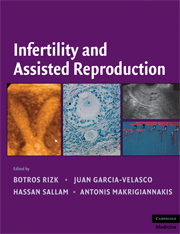Book contents
- Frontmatter
- Contents
- Contributors
- Foreword
- Preface
- Introduction
- PART I PHYSIOLOGY OF REPRODUCTION
- PART II INFERTILITY EVALUATION AND TREATMENT
- PART III ASSISTED REPRODUCTION
- 38 Medical Strategies to Improve ART Outcome: Current Evidence
- 39 Surgical Preparation of the Patient for In Vitro Fertilization
- 40 IVF in the Medically Complicated Patient
- 41 Polycystic Ovary Syndrome and IVF
- 42 Endometriosis and Assisted Reproductive Technology
- 43 Evidence-Based Medicine Comparing hMG/FSH and Agonist/Antagonist and rec/Urinary hCG/LH/GnRH to Trigger Ovulation
- 44 Luteal Phase Support in Assisted Reproduction
- 45 Thrombophilia and Implanation Failure
- 46 Intrauterine Insemination
- 47 The Prediction and Management of Poor Responders in ART
- 48 Oocyte Donation
- 49 In Vitro Maturation of Human Oocytes
- 50 Oocyte and Embryo Freezing
- 51 Cryopreservation of Male Gametes
- 52 The Management of Azoospermia
- 53 Spermatid Injection: Current Status
- 54 Optimizing Embryo Transfer
- 55 Single Embryo Transfer
- 56 Blastocyst Transfer
- 57 Clinical Significance of Embryo Multinucleation
- 58 Quality and Risk Management in the IVF Laboratory
- 59 The Nurse and REI
- 60 Understanding Factors That Influence the Assessment of Outcomes in Assisted Reproductive Technologies
- 61 The Revolution of Assisted Reproductive Technologies: How Traditional Chinese Medicine Impacted Reproductive Outcomes in the Treatment of Infertile Couples
- 62 Complications of Assisted Reproductive Technology
- 63 Ectopic and Heterotopic Pregnancies Following in Vitro Fertilization
- 64 The Impact of Oxidative Stress on Female Reproduction and ART: An Evidence-Based Review
- 65 PGD for Chromosomal Anomalies
- 66 Preimplantation Genetic Diagnosis for Single-Gene Disorders
- 67 Epigenetics and ART
- 68 Congenital Anomalies and Assisted Reproductive Technology
- PART IV ETHICAL DILEMMAS IN FERTILITY AND ASSISTED REPRODUCTION
- Index
- Plate section
- References
56 - Blastocyst Transfer
from PART III - ASSISTED REPRODUCTION
Published online by Cambridge University Press: 04 August 2010
- Frontmatter
- Contents
- Contributors
- Foreword
- Preface
- Introduction
- PART I PHYSIOLOGY OF REPRODUCTION
- PART II INFERTILITY EVALUATION AND TREATMENT
- PART III ASSISTED REPRODUCTION
- 38 Medical Strategies to Improve ART Outcome: Current Evidence
- 39 Surgical Preparation of the Patient for In Vitro Fertilization
- 40 IVF in the Medically Complicated Patient
- 41 Polycystic Ovary Syndrome and IVF
- 42 Endometriosis and Assisted Reproductive Technology
- 43 Evidence-Based Medicine Comparing hMG/FSH and Agonist/Antagonist and rec/Urinary hCG/LH/GnRH to Trigger Ovulation
- 44 Luteal Phase Support in Assisted Reproduction
- 45 Thrombophilia and Implanation Failure
- 46 Intrauterine Insemination
- 47 The Prediction and Management of Poor Responders in ART
- 48 Oocyte Donation
- 49 In Vitro Maturation of Human Oocytes
- 50 Oocyte and Embryo Freezing
- 51 Cryopreservation of Male Gametes
- 52 The Management of Azoospermia
- 53 Spermatid Injection: Current Status
- 54 Optimizing Embryo Transfer
- 55 Single Embryo Transfer
- 56 Blastocyst Transfer
- 57 Clinical Significance of Embryo Multinucleation
- 58 Quality and Risk Management in the IVF Laboratory
- 59 The Nurse and REI
- 60 Understanding Factors That Influence the Assessment of Outcomes in Assisted Reproductive Technologies
- 61 The Revolution of Assisted Reproductive Technologies: How Traditional Chinese Medicine Impacted Reproductive Outcomes in the Treatment of Infertile Couples
- 62 Complications of Assisted Reproductive Technology
- 63 Ectopic and Heterotopic Pregnancies Following in Vitro Fertilization
- 64 The Impact of Oxidative Stress on Female Reproduction and ART: An Evidence-Based Review
- 65 PGD for Chromosomal Anomalies
- 66 Preimplantation Genetic Diagnosis for Single-Gene Disorders
- 67 Epigenetics and ART
- 68 Congenital Anomalies and Assisted Reproductive Technology
- PART IV ETHICAL DILEMMAS IN FERTILITY AND ASSISTED REPRODUCTION
- Index
- Plate section
- References
Summary
INTRODUCTION
Over the past three decades basic research has culminated in many significant advances in human assisted conception (Edwards 2004). An example of this is the relatively recent development of more physiological culture conditions. By employing such conditions, it has become possible to culture the human embryo to the blastocyst stage as a matter of routine (Gardner and Lane 1997). Clinics now have more options regarding the day of embryo transfer, giving increased flexibility in scheduling. Subsequently, the question raised is, is there an optimal day for embryo transfer following IVF in the human? In this chapter, the probable advantages of blastocyst transfer are discussed and the clinical data reviewed.
There are numerous potential benefits of blastocyst transfer in human IVF, which are summarized in Table 56.1. Not all sperm or oocytes are destined to give rise to a viable embryo (Tesarik 1994). By culturing the human embryo past the cleavage stages, that is, past embryonic genome activation (Braude et al. 1988), it is feasible to study the embryo properly. A key factor in determining transfer outcome in animal models is the synchronization of the embryo with the female reproductive tract. In all mammalian species studied to date, including nonhuman primates (Marston et al. 1977), the transfer of embryos to the uterus prior to compaction (and, therefore, before the generation of the first transporting epithelium) results in greatly reduced pregnancy rates compared to the transfer of morulae or blastocysts.
- Type
- Chapter
- Information
- Infertility and Assisted Reproduction , pp. 531 - 539Publisher: Cambridge University PressPrint publication year: 2008
References
- 2
- Cited by



